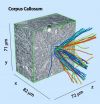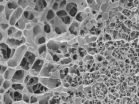(Press-News.org) This press release is available in German.
What happens in the brain when we see, hear, think and remember? To be able to answer questions like this, neuroscientists need information about how the millions of neurons in the brain are connected to each other. Scientists at the Max Planck Institute for Medical Research in Heidelberg have taken a crucial step towards obtaining a complete circuit diagram of the brain of the mouse, a key model organism for the neurosciences. The research group working with Winfried Denk has developed a method for preparing the whole mouse brain for a special microscopy process. With this, the resolution at which the brain tissue can be examined is so high that the fine extensions of almost every single neuron are visible.
Neurons transmit information through their extensions – the axons – and form a complex network of connections, which provides the basis for all information processing in the brain. Analysing this network under the microscope is one of the biggest challenges facing the neurosciences. Most axons are less than one micrometre thick, some even smaller than 100 nanometres. "The electron microscope is the only microscope with a high enough resolution to enable individual axons lying next to each other to be distinguished from each other," says Winfried Denk. Despite their minute diameter, axons can become very long and extend from one end of the brain to the other. To obtain an overall picture of a brain, the researchers have to analyse large pieces of tissue.
In 2004, scientists working with Denk developed a new method that enabled them to do just this: "serial block-face" scanning electron microscopy. To examine tissue using this method, it must be fixed, stained and embedded in synthetic material. This works for small pieces of tissue, but up to now it was not possible for tissue the size of a mouse brain. In a current study, Shawn Mikula from Denk's department succeeded in preparing a mouse brain in such a way that he was able to analyse it using block-face microscopy and trace the axons. The Max Planck research group would now like to image a whole brain with the "serial block-face" microscope so that they can study the neuronal connections in the entire mouse brain.
In their latest study, the Heidelberg-based researchers demonstrated that the brain of a mouse can be prepared in a way that enables it to be analysed whole using "block-face" electron microscopy. The challenge facing the scientists was to treat a large piece of tissue so that it is evenly fixed and stained right through to the inside. To do this, they developed a complex process in which the brain is treated in different fixing and staining solutions for days.
With scanning electron microscopy, an electron beam scans the surface of a tissue section. A single electron microscope image thus corresponds to a cross-sectional view through the tissue. To obtain a three-dimensional image of a tissue, it is cut in fine sections using traditional methods, and these are then microscoped individually. This approach is not only tedious, it is also error-prone. Block-face microscopy overcomes this problem. This involves inserting an entire piece of tissue in the microscope and scanning the surface. Only then is a thin section cut, and the layer below is scanned. This makes it easier to combine the data on the computer.
In an initial analysis of the method, the scientists followed the axons of 50 randomly selected neurons and marked them by hand. The axons can be clearly reconstructed using the process. "However, it would take far too long to trace all of the neurons in this way as a mouse brain consists of around 75 million neurons," says Denk. Therefore, the image evaluation must be automated. "Our images have sufficient resolution and contrast to follow all myelinated axons. If we manage to scan an entire brain in the years to come, this should provide a major incentive for computer scientists to develop the necessary analysis methods."
A detailed map of the connections in the brain will make a major contribution to the clarification of neuronal functions. "Every theory on brain function is based on an idea of the corresponding information paths in the brain. It is very important that we find out about the connections between the nodes so that we can distinguish between different models of brain function," explains Denk.
INFORMATION:
Original publication:
Shawn Mikula, Jonas Binding, Winfried Denk
Staining and Embedding the Whole Mouse Brain for Electron Microscopy
Nature Methods, Online publication 21 October 2012, doi:10.1038/nmeth.2213
A circuit diagram of the mouse brain
Max Planck scientists aim to analyze a whole mouse brain under the electron microscope
2012-10-23
ELSE PRESS RELEASES FROM THIS DATE:
Lung mucus gel scaffold prevents nanoparticles from getting through
2012-10-23
Mucus coats our airways' internal surfaces. The viscous gel humidifies the lungs and prevents viruses and other small particles like diesel soot from entering the body unchecked. Previously unclear was the extent to which such nanoparticles are able to move through the lungs' mucus. Here, the research evidence was contradictory. Scientists could not explain why, in inhaled medication development, drug nanoparticles often simply got stuck in the mucus never making it to their target destination inside the lung cells.
Now, as part of a German Research Foundation (DFG)-funded ...
The complex association between moderate alcohol consumption and breast cancer
2012-10-23
An excellent review article from two scientists at the National Institute on Alcohol Abuse and Alcoholism in the USA to be published in Alcohol Clin Exp Res 2012, describes the epidemiologic and basic scientific evidence linking alcohol consumption to the risk of breast cancer.
The authors point out deficiencies in the epidemiologic data, especially that the pattern of drinking (regular moderate versus binge drinking) has generally not been taken into consideration, important given that binge drinking is associated with much higher blood alcohol concentrations and acetaldehyde ...
TIM and TAM: 2 paths used by the Dengue virus to penetrate cells
2012-10-23
By demonstrating that it is possible to inhibit the viral infection in vitro by blocking the bonding between the virus and these receptors, the researchers have opened the way to a new antiviral strategy. These works were published on line in the review "Cell Host & Microbe" of October 18, 2012.
The Dengue virus circulates in four different forms (four serotypes). It is transmitted to humans by mosquitoes. It is a major public health problem. Two billion people throughout the world are exposed to the risk of infection and 50 million cases of Dengue fever are recorded by ...
19 species of ferns named for Lady Gaga
2012-10-23
DURHAM, N.C. -- Pop music megastar Lady Gaga is being honored with the name of a new genus of ferns found in Central and South America, Mexico, Arizona and Texas. A genus is a group of closely related species; in this case, 19 species of ferns will carry the name Gaga.
At one stage of its life, the new genus Gaga has somewhat fluid definitions of gender and bears a striking resemblance to one of Gaga's famous costumes. Members of the new genus also bear a distinct DNA sequence spelling GAGA.
Two of the species in the Gaga genus are new to science: Gaga germanotta from ...
Moffitt researchers study how patterns, timing of sunlight exposure contribute to skin cancers
2012-10-23
Researchers at Moffitt Cancer Center, the University of South Florida and the International Agency for Research on Cancer in France have studied the patterns and timing of sunlight exposure and how each is related to two nonmelanoma skin cancers – basal cell carcinoma and squamous cell carcinoma.
This study, published in the open-access journal BioMed Central, is the first case-control study to simultaneously evaluate identical patterns and timing of sunlight exposure as they are related to basal cell and squamous cell carcinomas in the same U.S. population with high ...
Vanderbilt researchers find that diabetes drug could be effective in treating addiction
2012-10-23
Vanderbilt researchers are reporting today that a drug currently used to treat type 2 diabetes could be just as effective in treating addiction to drugs, including cocaine.
The findings, published online today as a Letter To The Editor in the journal Molecular Psychiatry, could have far-reaching implications for patients worldwide who suffer from addiction.
"What we have demonstrated is that a brain mechanism already known to be therapeutic for the treatment of diabetes also appears to be implicated in at least certain types of drug addiction," said Gregg Stanwood, ...
New American Chemical Society videos celebrate 25 years of National Chemistry Week
2012-10-23
WASHINGTON, Oct. 23, 2012 — The American Chemical Society (ACS) today released two new videos celebrating the 25th Anniversary of National Chemistry Week (NCW). The videos, from the world's largest scientific society, coincide with the start of this year's NCW, being observed in hundreds of communities around the country. Both videos are available now at www.BytesizeScience.com.
One video is a new episode of ACS' award-winning Bytesize Science series. It highlights research behind this year's NCW theme — nanotechnology. The second video is a retrospective on the history ...
Engaging parents leads to better treatments for children with adhd
2012-10-23
Philadelphia, October 23 Pediatricians and researchers at The Children's Hospital of Philadelphia's(CHOP) have developed a first-of-its kind tool to help parents and health care providers better treat ADHD (attention deficit-hyperactivity disorder). The new, three-part survey helps steer families and doctors toward "shared decision-making", an approach proven to improve healthcare results in adults, but not widely used in pediatric settings. The results of the CHOP study are published in the journal Academic Pediatrics.
"Shared decision-making in health care means ...
Lubricants from vegetable oil
2012-10-23
Epoxides are highly reactive organic compounds comprised of a triple ring with two carbon atoms and one oxygen atom. Among other things, the chemicals industry uses them for the production of lubricants for vehicles and engines, as well as surfactants and emulsifiers for detergents and cleansers. Until now, epoxides have been based primarily on source materials procured from petroleum. Researchers at the Fraunhofer Institute for Interfacial Engineering and Biotechnology IGB have engineered a chemical-enzymatic process that now enables vegetable oil-based production, at ...
Neutron experiments give unprecedented look at quantum oscillations
2012-10-23
OAK RIDGE, Tenn., Oct. 23, 2012 -- Researchers at the Department of Energy's Oak Ridge National Laboratory have found that nitrogen atoms in the compound uranium nitride exhibit unexpected, distinct vibrations that form a nearly ideal realization of a physics textbook model known as the isotropic quantum harmonic oscillator.
In the experiment on the uranium nitride crystal -- with each of the light nitrogen atoms centered in a cage of heavier uranium atoms -- neutron scattering at ORNL's Spallation Neutron Source (SNS) revealed an unexpected series of distinct and evenly ...
LAST 30 PRESS RELEASES:
UF dives deep into predicting storm damage with computer models
A stormy ocean voyage yields insights on the global carbon cycle
Scientists identify first non-coding gene that controls cell size
Demonstration of altermagnetism in RuO₂ thin films -- A new magnetic material for the AI era
Penn researchers awarded $25M to conduct trial using smartphones to fight heart disease
PCORI awards funding for new patient-centered healthcare research
Exploring the origins of the universe: 145 low-noise amplifiers complete ALMA telescopes
Empress cicada wings help illuminate molecular structure
Using sound waves to detect helium
Time burden in patients with metastatic breast and ovarian cancer from clinic and home demands
Researchers discover bias in AI models that analyze pathology samples
Scientists ID potential way to prevent brain injuries from triggering Alzheimer's
MASTER 2nd Open Call: Execution period kick-off
Algae for health in food and pharma
Advanced microrobots driven by acoustic and magnetic fields for biomedical applications
Chicago health information leader recognized for raising CPR readiness and blood pressure awareness
The Intimate Animal, a new book from Kinsey Institute Executive Director Dr. Justin Garcia
When blue-collar workers lose union protection, they try self-employment
New video dataset to advance AI for health care
MEA-based graph deviation network for early autism syndrome signatures in human forebrain organoids
New modeling approach sheds light on rare gut disease
Study documents potentially hazardous flame retardants in firefighter gear
Can certain bacteria regulate aging of the immune system and its related alterations?
AI model helps diagnose often undetected heart disease from simple EKG
There are fewer online trolls than people think
Cell membrane fluctuations produce electricity
Jeonbuk National University study shows positive parenting can protect adolescents against self-harm
Surface-engineered ZnO nanocrystals to tackle perfluoroalkyl substance contamination
This new understanding of T cell receptors may improve cancer immunotherapies
A new fossil face sheds light on early migrations of ancient human ancestor
[Press-News.org] A circuit diagram of the mouse brainMax Planck scientists aim to analyze a whole mouse brain under the electron microscope



